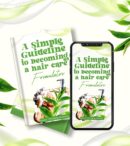1. Moisturize regularly: Coarse hair tends to be dry, so it’s important to keep it well moisturized. Incorporate a leave-in conditioner or hair oil into your routine for extra moisture and hydration.
2. Deep condition regularly: Deep conditioning treatments help to nourish and soften the hair. Use a deep conditioner once a week or every two weeks to replenish moisture, improve elasticity, and make your hair more manageable.
3. Avoid excessive heat: Heat styling tools can further dry out and damage coarse hair. If you do use heat, always apply a heat protectant spray beforehand and use the lowest heat setting possible.
4. Use a wide-toothed comb or finger detangling: Coarse hair is prone to tangling, so use a wide-toothed comb or your fingers to detangle your hair. Start from the ends and work your way up to reduce breakage.
5. Opt for protective hairstyles: Protective hairstyles like braids, twists, buns, or updos can help manage coarse hair by minimizing manipulation and reducing exposure to environmental factors. These hairstyles can also help retain moisture and promote hair growth.
6. Regular trims: Trim your hair regularly to get rid of split ends and prevent breakage. Regular trims help maintain the health and appearance of your hair.
7. Consider professional treatments: Salon treatments such as protein treatments can temporarily soften the hair and make it more manageable. Consult with a hairstylist to determine if these treatments are suitable for your hair and desired style.
8. Embrace natural styling techniques: Explore natural styling techniques such as twist-outs, braid-outs, bantu knots, or flexi rod sets. These techniques can help elongate and define your natural texture while reducing the appearance of coarseness.
9. Be patient and gentle: Changing the texture of your hair takes time. Be patient with your hair and embrace its natural characteristics.
N:B Remember, each person’s hair is unique, and what works for one may not work for another. It may take some experimentation and trial-and-error to find the best routine and products for your hair.
10. Seek professional advice if needed: Consider consulting with a hairstylist who specializes in natural hair or a trichologist who can provide personalized guidance and support during your transition.
Remember, everyone’s hair journey is unique, so it’s important to listen to your hair’s needs and adjust your routine accordingly. Stay consistent with your hair care practices, be gentle with your hair, and embrace the beauty of your natural texture.












